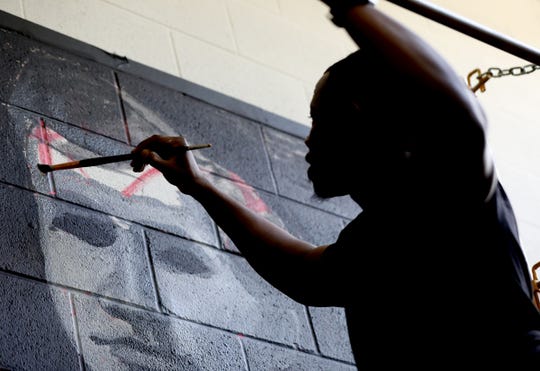He passed as a white student at U-M — but was actually college’s first black enrolleePosted in Articles, Arts, Biography, Campus Life, History, Media Archive, Passing, United States on 2019-10-24 15:03Z by Steven |
He passed as a white student at U-M — but was actually college’s first black enrollee
Detroit Free Press
2019-10-19
 Tylonn J. Sawyer, 42 of Detroit, works on the mural he’s been painting inside the University of Michigan, Modern Languages Building on campus in Ann Arbor on Saturday, October 19, 2019. The mural titled “First Man: Samuel Codes Watson (Acrylic)” is dedicated to the first African-American to attend the University of Michigan, Samuel Codes Watson. In 1853, Samuel Codes Watson was the first African American student admitted to the [University of] Michigan. (Photo: Eric Seals, Eric Seals/Detroit Free Press) |
In 1853, Samuel Codes Watson became the first black student admitted to the University of Michigan at a time where higher education for African Americans was nearly impossible.
Studying to become a doctor, Watson would go on to receive his M.D. from Cleveland Medical College in 1857, being one of the first black people to do so. He later became Detroit’s first elected African-American city official and the city’s richest property owner by 1867.
Now, Tylonn Sawyer is bringing more awareness to Watson’s story through a work of art.
The Detroit artist is working with two U-M students on a mural to honor Watson. He’s spent the last two weekends painting inside U-M’s Modern Language Building. The mural was to be completed Saturday.
The project is part of Sawyer’s residency at the Institute for the Humanities, which will include his exhibition, “White History Month Vol. 1,” and a series of student engagement opportunities…
…”I was trying to find something not too heavy-handed, but something that could fit the theme (of the exhibit) and then it dawned on me, I wanted to know who was the first black person to attend the school,” he said.
However, since Watson was of mixed race, he passed as white during his two years at U-M. Fortunately for Sawyer, that fact made the doctor more compelling to paint for “White History.”
“That fascinates me that there was a black person who had white privilege and was cognizant of his ethnicity,” he said. “When you really think about it, he kinda wasn’t a black person when he was there. That’s such a juxtaposition for me.”…
Read the entire article here.

